Robotic Total knee replacement
Robotic Total knee replacement

Hip Replacement Overview
The knee joint is the point at which the femur bone of the thigh meets the tibia bone of the lower leg. All the components of the knee – bones, cartilage, synovial membrane, ligaments, tendons and muscles – must work together properly for the knee to move smoothly.
Cartilage is a protective cushioning that keeps the bones from rubbing against one another.
In a healthy knee, a thin, smooth tissue liner called the synovial membrane releases a fluid that lubricates the knee, reducing friction as the bones move.
Meet the NAVIO Surgical System, a robotics-assisted knee surgery platform that adds an extra layer of pre-surgical planning and improved accuracy for partial and total knee replacement procedures.
 NAVIO ROBOTICS-ASSISTED KNEE REPLACEMENT SURGERY
NAVIO ROBOTICS-ASSISTED KNEE REPLACEMENT SURGERY
Your knee replacement surgery is unique, based on your knee anatomy and the implant used. Designed to help ensure your knee replacement is positioned and aligned correctly, surgeons use the NAVIO Surgical System. Proper positioning of the implant is important because implant alignment is a crucial factor in determining how long your implant may last.

Decades of innovation in knee replacement surgery
Surgical techniques have evolved considerably since the earliest knee implant procedures were performed in 1968. These procedures relied on manual guides, external pins and cutting jigs to remove damaged bone and place the prosthetic implant.
Eventually more advanced implant positioning techniques were introduced that used long rods drilled into the central canal of the femur (thigh bone). These rods provide an attachment point for surgical cutting guides. More recent improvements introduced CT (computerized tomography) scan/MRI image guidance to create an individualized computer-generated surgical plan for each patient.
The latest innovation is the NAVIO Surgical System, a robotics-assisted platform that uses CT-free technology for accurate implant sizing and positioning without the need for rods. The NAVIO Surgical System can be used for either a partial or total knee replacement procedure.

NAVIO system benefits: accuracy, less exposure to CT radiation
The NAVIO system offers two important benefits for people undergoing a knee replacement procedure. First, it helps your surgeon create a highly individualized plan that is specific to the unique shape and motion of your knee. Traditional planning may require CT scans, a series of images similar to x-rays that shows cross-sections of your knee. While other robotic-assisted platforms require CT scans, the NAVIO system works without them, meaning you are not exposed to the potentially harmful radiation experienced with this type of imaging.
The second benefit is robotic assistance. This combination of advanced technology is designed to help your surgeon and may result in more accuracy, giving you better long-term outcomes.
The NAVIO system is used for both partial and total knee replacement, which are distinctly different procedures. Here’s a bit more information on how the NAVIO system is used in these surgeries:
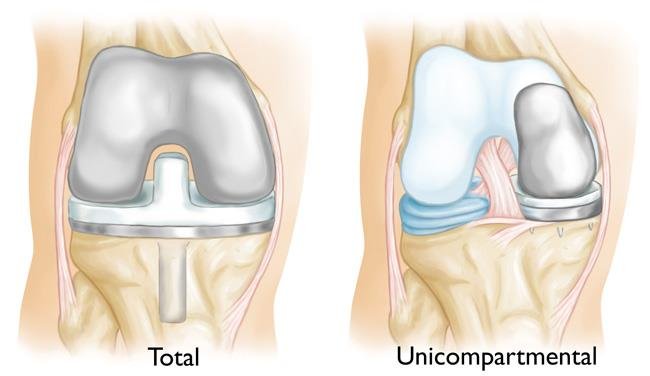
Partial knee replacement
In partial knee replacement, your supporting tissue and ligaments that help stabilize your knee are spared and only the damaged portion of the knee is replaced. This means that healthy cartilage and bone remain intact to help your knee joint move smoothly with the prosthetic implant. Patients with osteoarthritis in only one area of their knee may be candidates for partial knee replacement.
Patients who undergo partial knee replacement often report a ‘more normal’ feeling knee, less pain and quicker rehabilitation.

Robotics-assisted planning and partial knee surgical procedure
Using the NAVIO system, your surgeon creates a 3D representation of the unique shapes and profiles of your knee without the need of a pre-operative CT scan.
Using all of this information your surgeon can then determine the correct size and position of the implant. Implant size and position is critical to knee alignment and stability.
Next, your surgeon uses robotic assistance of NAVIO to physically remove only the damaged bone, preparing the site for the prosthesis, before placing and adjusting your partial knee implant.

Total knee replacement
In total knee replacement, the entire knee joint is replaced with a prosthetic implant designed to replicate the shape, motion and stability of your natural knee joint. Total knee replacement is one of the most common procedures performed in all of medicine, with over 600,000 performed in the U.S. every year. Ninety percent of people who receive a total knee replacement experience a dramatic decrease in knee pain, and an improvement in their ability to perform daily activities.

Robotics-assisted planning, and total knee surgery guidance
Just as in the partial knee procedure described above, your surgeon creates a 3D representation of the unique anatomy of your knee without the need of a pre-operative CT scan. Your surgeon uses your knee anatomy information to determine the correct size and position of the implant, and creates a surgery plan unique to your anatomy.

DISCLAIMER
Individual results may vary. There are risks associated with any surgical procedure including NAVIO-enabled Knee Replacement. NAVIO is not for everyone. Children, pregnant women, patients who have mental or neuromuscular disorders that do not allow control of the knee joint, and morbidly obese patients and patients contraindicated for UKR, PFA and TKA should not undergo a NAVIO procedure. Consult your physician for details to determine if NAVIO is right for you.

IMPORTANT SAFETY NOTES
Individual results of joint replacement vary. Implants are intended to relieve knee pain and improve function, but may not produce the same feel or function as your original knee. There are potential risks with knee replacement surgery such as loosening, wear and infection that may result in the need for additional surgery. Patients should not perform high impact activities such as running and jumping unless their surgeon tells them that the bone has healed and these activities are acceptable. Early device failure, breakage or loosening may occur if a surgeon’s limitations on activity level are not followed.
 PARTIAL KNEE REPLACEMENT WITH THE NAVIO SURGICAL SYSTEM
PARTIAL KNEE REPLACEMENT WITH THE NAVIO SURGICAL SYSTEM
For people suffering from knee pain caused by osteoarthritis, whose damage is limited to a single compartment or area of the knee, partial knee replacement may be an option because it preserves healthy bone and ligaments while replacing the damaged area.The NAVIO Surgical System uses robotics-assisted technology to help tailor partial knee replacement procedures to the unique shape and motion of each patient’s knee anatomy.
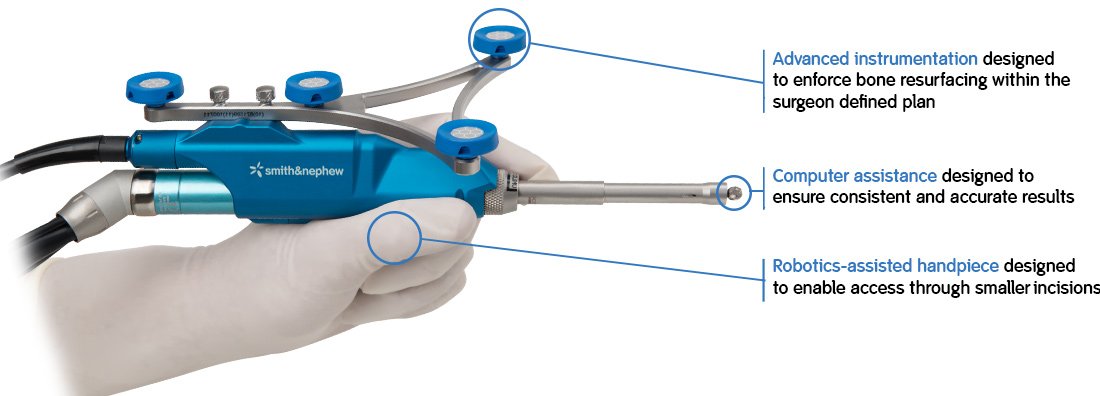
Robotics-assisted Planning for Better Surgical Outcome
While it may seem counterintuitive, replacing only part of a knee joint can be more challenging than replacing the entire joint. This is because partial knee replacement must achieve an exact balance between the new implant – made of metal and plastic components – and the remaining portions of your natural anatomy made of bone and cartilage. As a result, one of the primary challenges of all partial knee replacements is accurately positioning the implant for each unique patient. Even minor changes in an implant’s size or placement can cause the knee to function poorly or result in early failure of the implant and the need for future surgery.
The NAVIO Surgical System addresses the challenge of partial knee replacement by using both computer and robotic assistance to accurately map the surface of your knee, align your implant to your anatomy, and physically remove the bone necessary to place your new implant.3 This added level of assistance is important because implant alignment is a crucial factor in determining how long the implant will last.
Robotic Knee Surgery without Radiation
Other robotic knee replacement systems use computerized tomography, or CT, scans to help a surgeon visualize a patient’s knee anatomy. While CT scans are effective at showing the layers of knee anatomy, they can expose the patient to potentially harmful radiation. In fact, a single CT scan is equivalent to the radiation exposure received in 48 chest X-rays.
The NAVIO system eliminates the need for CT scans by using an advanced computer program (similar to GPS navigation on your phone) to collect anatomic and alignment information about your knee. Once captured, this information is used to build an accurate, computer-rendered 3D model of your knee that your surgeon will use to plan your surgery.
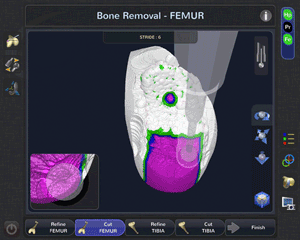

NAVIO Robotics-assisted Partial Knee Replacement Surgery
After all of the information about your knee is gathered and your surgical plan is created, your surgeon will use a robotics-assisted surgical tool (the NAVIO handpiece) to physically remove the damaged surface of your bone so that your new implant fits properly. Using the same 3D model of your knee, the handpiece is able to differentiate between the damaged areas that need to be removed, and the healthy areas that will remain. The NAVIO handpiece uses a burr that removes damaged bone for your implant.
The NAVIO system doesn’t replace your surgeon. Rather, it assists your surgeon by adding an extra layer of planning to the procedure.

Partial Knee Replacement with Traditional Techniques
By comparison, traditional surgical methods for partial knee replacement use a combination of long, metal IM (Intra-medullary) rods that are drilled into the central bone canal to determine anatomic alignment and mechanical cutting guides that help guide a saw blade as it removes the bone necessary to place the implant. The NAVIO Surgical System helps tailor your partial knee replacement procedure to your unique knee anatomy without the need for intramedullary rods or cutting guides
 TOTAL KNEE REPLACEMENT SURGERY WITH THE NAVIO SURGICAL SYSTEM
TOTAL KNEE REPLACEMENT SURGERY WITH THE NAVIO SURGICAL SYSTEM
More than 600,000 total knee replacement procedures are performed each year in the U.S. and more than 90% of these patients experience a dramatic relief in knee pain and are better able to perform common activities.1 The NAVIO Surgical System delivers robotics-assisted tools designed to help tailor your knee replacement surgery to the unique shape and motion of your knee.

Robotics-assisted knee replacement planning with the NAVIO System
The total knee replacement procedure starts with your unique anatomy in mind. By the time your procedure is complete, the damaged bones and cartilage within your knee joint will be removed and replaced with new implant components. Each of these implant components must fit accurately and be aligned to your natural anatomy if they are to provide you with the best outcome possible. The challenge of aligning your implant and preparing your bones to accept it can be complex, invasive and time consuming because no two knee joints are exactly the same.
The NAVIO Surgical System is designed to help your surgeon not only plan your surgery based on your unique anatomy, but also position your total knee implant using a combination of computer and robotic assistance. The NAVIO procedure starts with an advanced computer system that gathers accurate anatomic and alignment information about your joint that your surgeon will use to create your specific surgical plan.
This extra layer of data collection and planning is designed to help ensure your knee procedure is performed exactly as your surgeon intends and that your implant is positioned as accurately as possible for the best long-term outcome.
CT-free
Other robotic-assisted knee replacement systems use computerized tomography, or CT, scans to help a surgeon visualize a patient’s knee anatomy. While CT scans are effective at showing the layers of knee anatomy, they can expose the patient to potentially harmful radiation. In fact, a single CT scan is equivalent to the radiation exposure received in 48 chest X-rays.
The NAVIO system eliminates the need for CT scans by using an advanced computer program to collect anatomic and alignment information about your knee. Once captured, this information is used to build an accurate, computer-rendered 3D model of your knee that your surgeon will use to plan your surgery.
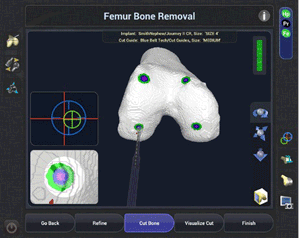

Total Knee Replacement Surgery without rods
Another method that can be used to determine the anatomic alignment of your new implants uses long, metal devices called intramedullary (IM) rods that are drilled into the central canal of the bone to show the alignment of the knee in relation to the hip. These rods are then used to attach the cutting guides necessary to guide the surgeon’s saw blade as it shapes the bones to accept the new implants.
Because the NAVIO system has already gathered the anatomic alignment information about your knee, it eliminates the need for IM rods. Instead, your surgeon will use the system’s handheld robotics-assisted tool (the NAVIO handpiece) to accurately position the NAVIO-specific cut guides which are held in place with a few small pins instead of the IM rod. This process leaves the central canal of your bone untouched. Implant alignment is a crucial factor in determining how long the implant will last.
NAVIO Brings Robotics-assisted Accuracy to Total Knee Surgery
After removing the cutting guides, the prosthetic knee implants are implanted and your knee is checked to make sure it moves and is balanced correctly. It is important to understand that the NAVIO system doesn’t replace your surgeon. The procedure remains in the skilled hands of your surgeon, with the NAVIO system providing extra layers of planning and accuracy.
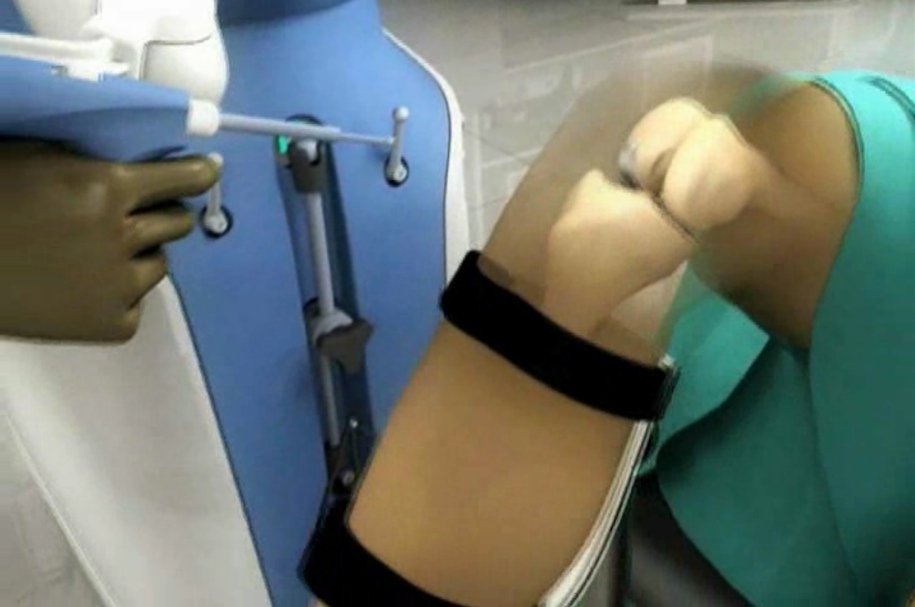
FAQ'S

What are the benefits of robotic joint replacement surgery?
Robotic Knee replacement Surgery technology is an innovative solution to conventional surgical methods for patients suffering from hip or knee joint pain.
The accurate alignment and positioning of joint implants is challenging in conventional hip and knee replacements. With the Robotic technology, our surgeons can now achieve greater precision.
Using a 3D image of each patient’s unique anatomy, the robotic technology helps guide the surgeon to stay within only the pre-determined area for greater accuracy in the positioning and alignment of the joint implant. The proper alignment of the implants results in quicker recovery times, more natural-feeling movement, and overall better outcomes for our patients.
How do I know if I'm a candidate Robotic knee replacement?
If you suffer from severe joint pain and conservative treatments have not provided adequate relief, you may be a candidate for a hip or knee replacement with Robotic technology.
Many factors come into consideration when determining if a patient is a candidate. It is important that you consult with your orthopaedic surgeon to determine if the Robotic technology is the right option for you.
Total knee replacement: Adults living with mid to late-stage osteoarthritis of the knee may be candidates for a total knee replacement with the Robotic knee Assisted Surgery System. Mid to late-stage osteoarthritis indicates the disease has affected more than two of the knee compartments: Medial, patellofemoral, or lateral.
Partial knee replacement: You may be a good candidate for partial knee replacement with Robotic technology if you are an adult living with early to mid-stage osteoarthritis that has not yet progressed to all three compartments of the knee. Knee joint replacement is intended for use in individuals with joint disease resulting from degenerative, rheumatoid and post-traumatic arthritis, and for moderate deformity of the knee.
Joint replacement surgery is not appropriate for patients with certain types of infections, any mental or neuromuscular disorder which would create an unacceptable risk of prosthesis instability, prosthesis fixation failure or complications in postoperative care, compromised bone stock, skeletal immaturity, severe instability of the joint, or excessive body weight.


How does the pre-operative plan work with the Robotic knee replacement?
Every patient’s anatomy is different. The Robotic knee technology allows the surgeon to create a customized plan for each patient based on a 3D virtual model of their individual anatomy. This allows the surgeon to perform the procedure as accurately as possible.
The surgeon captures a 3D model of the knee intra-operatively. The surgeon uses this 3D model to pre-plan your surgical procedure. The surgeon will know precisely where to prepare the bone for the implant, and the Robotic knee system guides the surgeon to stay within the pre-defined area. This helps to provide optimal placement and alignment of your implant.

How long does the surgery take?
In most cases, Robotic knee replacement surgery takes a little over an hour.
NOTE: Individual results vary. Not all patients will have the same post-operative recovery and activity level. See your orthopaedic surgeon to discuss your potential benefits and risks.

What can I expect after my surgery?
The recovery process will be different for each patient. A typical hospital stay after surgery with Robotic knee assisted technology may be a few days to a week after a partial or total knee replacement, or total hip replacement. Some patients will need a longer duration of stay depending on age, gravity of injury and other health factors.
For many, getting up and walking and beginning physical therapy exercises will be possible as soon as the day after surgery. Depending on your post-surgical plan, which will be determined by your surgeon, nurse, and physical therapist, you may need to use some assistance devices at home as part of your recovery.
Pain management will also be important to ensuring you as comfortable as possible during your recovery process, and your post-op plan may include pain medications.
Outpatient physical therapy is typically prescribed to begin one or two weeks out after surgery.

How soon can I return to work?
The recovery process will vary for each patient after surgery with Robotic knee technology. In most cases, if you have a sedentary job, you may be able to return to work within 3-6 weeks. Studies indicate that patients who undergo knee replacement may return to driving in four to six weeks. (1)Most knee replacement patients can except to return to low-impact activities by 3 months. Low-impact activities include hiking, biking, golfing.
Complete recovery from a total hip replacement with Robotic knee assisted technology can take from about 3 to 6 months.

What activities can I enjoy following knee replacement?
Realistic physical activities following recovery from a total knee replacement with Robotic knee assisted technology include walking, swimming, golfing, driving, light hiking, biking, dancing, and other low-impact sports.
Patients who have a partial knee replacement with Robotic knee assisted technology can expect even greater results, with many being able to return to a more active lifestyle. The recovery process will vary for each patient, and it will be important to follow your individual post-operative care instructions for optimal recovery.

How long does the implant last?
All joint implants have a limited life expectancy, and many factors play a role in the longevity of the implant. These include the patient’s age, weight, activity level, quality of bone stock, and compliance with doctor’s orders.
Proper alignment and positioning of the implants is also crucial to the life expectancy of the implant. With our Robotic knee Assisted Surgery System, our surgeons can achieve superior results in the alignment and positioning of the knee and hip joint implants, which results in overall better outcomes for our patients.
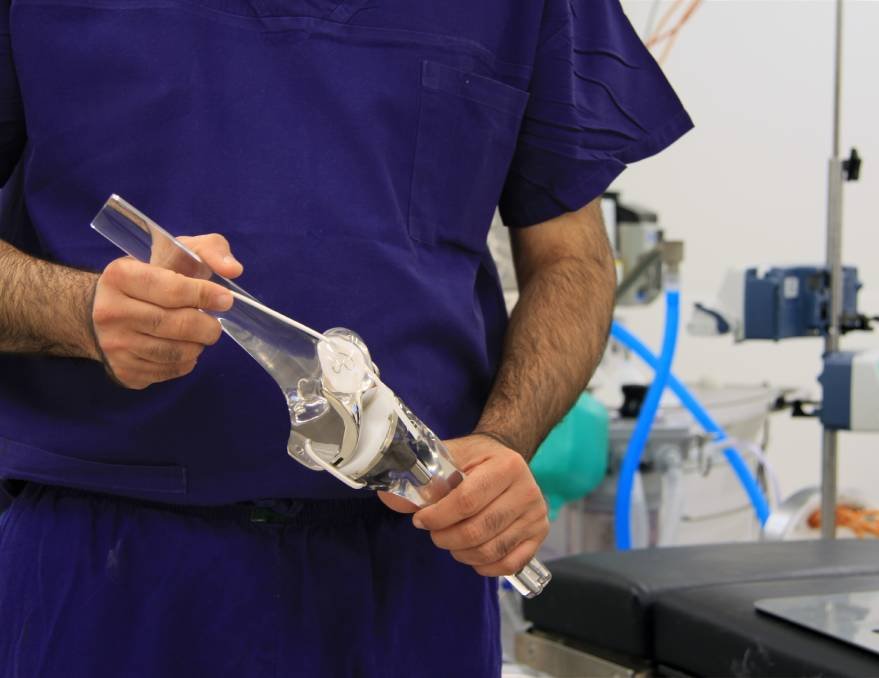
Will my implant set off a metal detector?
Most of today’s knee and hip joint implants are made of metal alloys and high grade plastics. So it is possible that the metal will set off airport security detectors. We recommend you inform the security agent of your implant before screening begins.
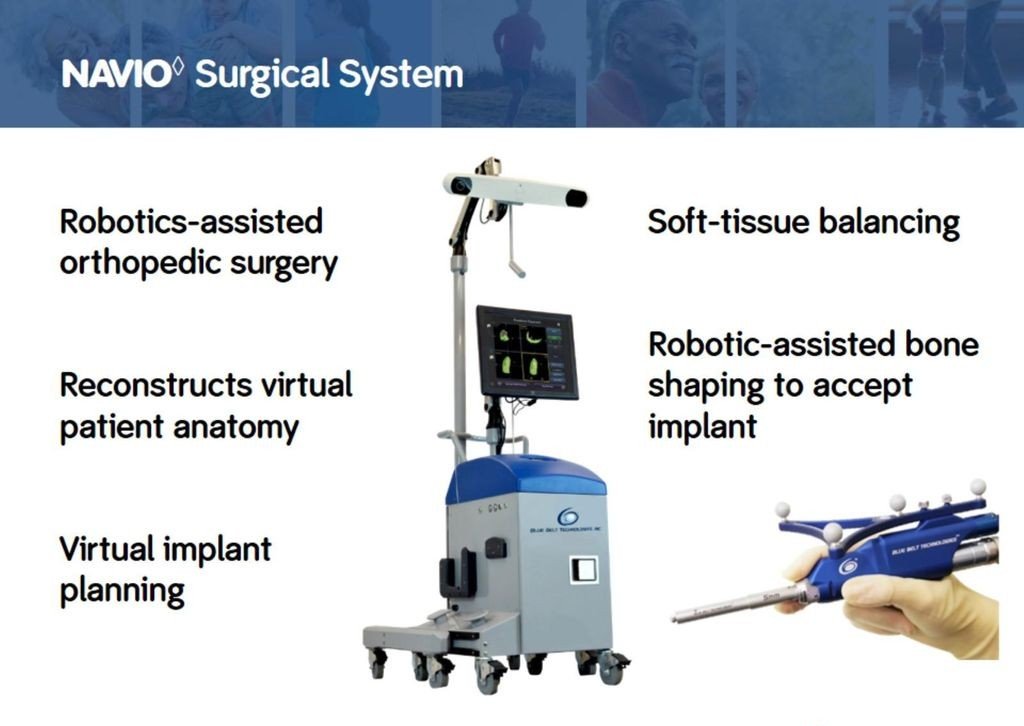
Is the orthopaedic Robotic knee assisted surgical technology FDA approved?
Yes. We use the NAVIO Surgical System™ brand Robotic Surgery Technology by Smith & Nephew, which is FDA approved.
